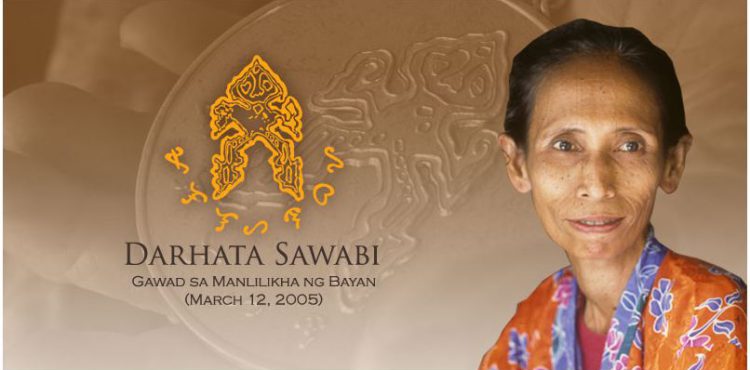
Darhata Sawabi
Textile Weaver
(Born: 4 March 1943)
Sulu
In Barangay Parang, in the island of Jolo, Sulu province, women weavers are hard at work weaving the pis syabit, the traditional cloth tapestry worn as a head covering by the Tausug of Jolo. “This is what we’ve grown up with,” say the weavers. “It is something we’ve learned from our mothers.” Darhata Sawabi is one of those who took the art of pis syabit making to heart.
The families in her native Parang still depend on subsistence farming as their main source of income. But farming does not bring in enough money to support a family, and is not even an option for someone like Darhata Sawabi who was raised from birth to do only household chores. She has never married. Thus, weaving is her only possible source of income. The money she earns from making the colorful squares of cloth has enabled her to become self-sufficient and less dependent on her nephews and nieces. A hand-woven square measuring 39 by 40 inches, which takes her some three months to weave, brings her about P2,000. These squares are purchased by Tausug for headpieces, as well as to adorn native attire, bags, and other accessories. Her remarkable proficiency with the art and the intricacy of her designs allows her to price her creations a little higher than others. Her own community of weavers recognizes her expertise in the craft, her bold contrasting colors, evenness of her weave and her faithfulness to traditional designs.
Pis syabit weaving is a difficult art. Preparing the warp alone already takes three days. It is a very mechanical task, consisting of stringing black and red threads across a banana and bamboo frame to form the base of the tapestry. At 48, and burdened by years of hard work, Sawabi no longer has the strength or the stamina for this. Instead, she hires one of the neighboring children or apprentice weavers to do it at the cost of P300. It is a substantial amount, considering the fact that she still has to spend for thread. Sawabi’s typical creations feature several colors, including the basic black and red that form the warp, and a particular color can require up to eight cones, depending on the role it plays in the design. All in all, it comes up to considerable capital which she can only recover after much time and effort.
Sawabi faces other challenges to her art as well. In the 1970s, when Jolo was torn apart by armed struggle, Sawabi and her family were often forced to abandon their home in search of safer habitats. The first time she was forced to abandon her weaving was very painful experience as it was impossible for her to bring the loom along with her to the forest where they sought refuge. They returned to their home to see the pis she had been working on for nearly a month destroyed by the fighting. There was nothing for her to do except pick up the pieces of her loom and start again. Because of the conflict, she and her family had been forced to relocate twice finally establishing their residence in Parang. During this time, Sawabi supported her family by weaving and selling her pieces to the participants in the conflict who passed through her village. Because of her dedication to her art, generations of traditional Tausug designs have been preserved and are available for contemporary appreciation and future study. She continues to weave at home, while teaching the other women of her community. In recent years, she has had several apprentices, and more and more people have bought her work.
Sawabi remains faithful to the art of pis syabit weaving. Her strokes are firm and sure, her color sensitivity acute, and her dedication to the quality of her products unwavering. She recognizes the need for her to remain in the community and continue with her mission to teach the art of pis syabit weaving. She had, after all, already been teaching the young women of Parang how to make a living from their woven fabrics. Some of her students are already teachers themselves. She looks forward to sharing the tradition of pis syabit weaving to the younger generations.
Source: Maricris Jan Tobias
